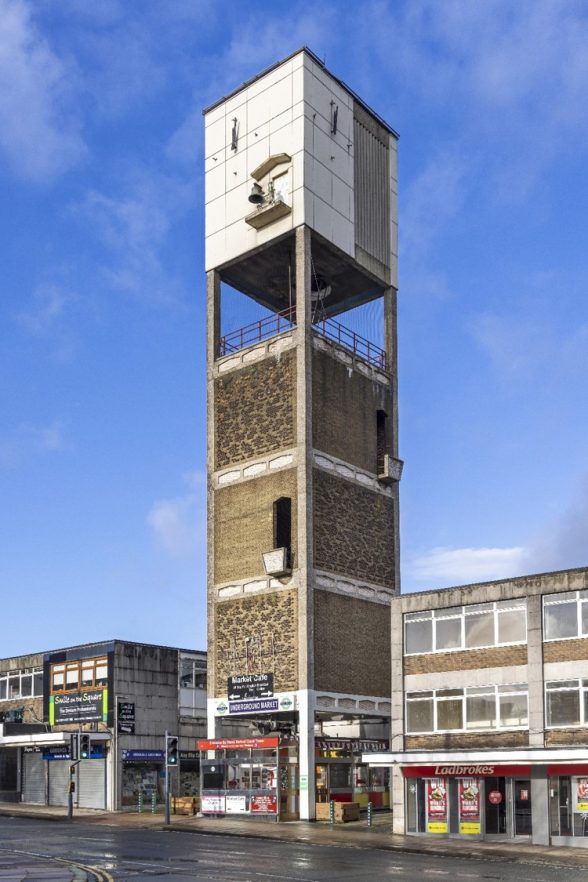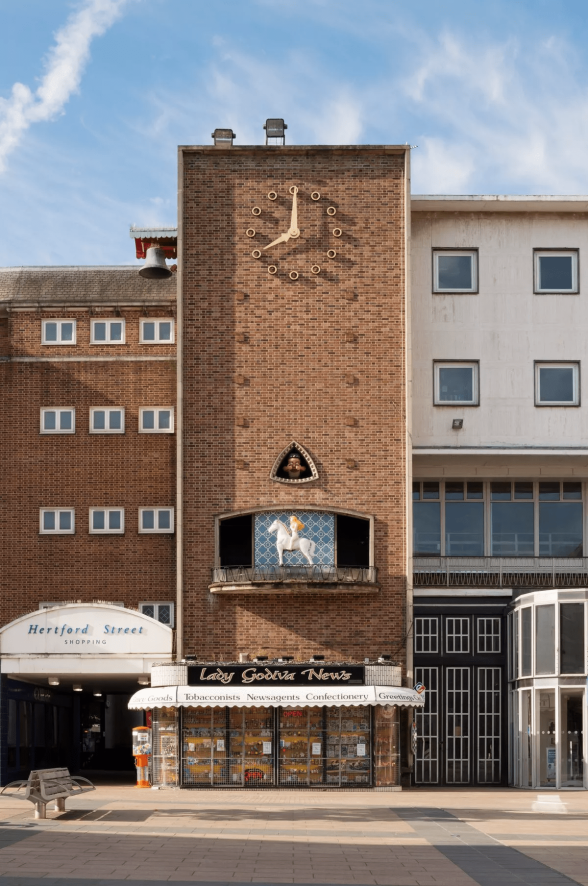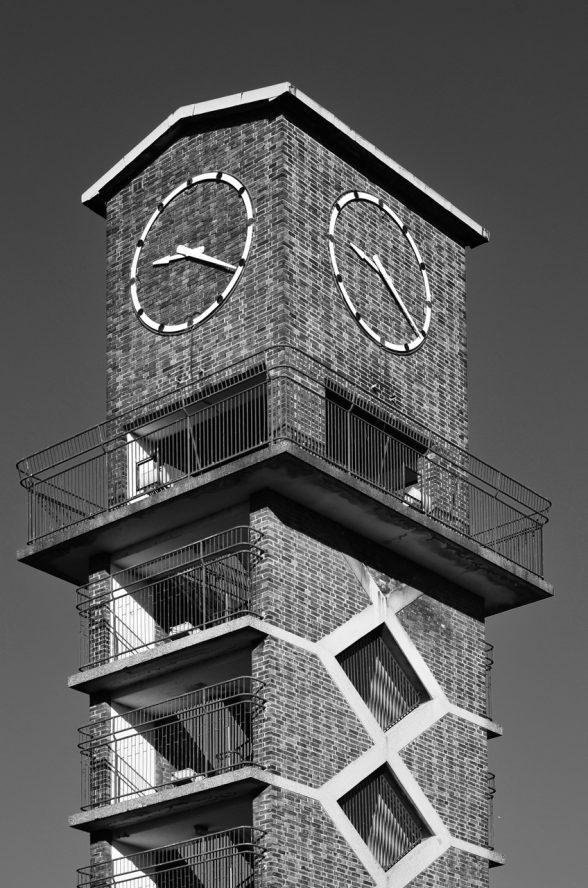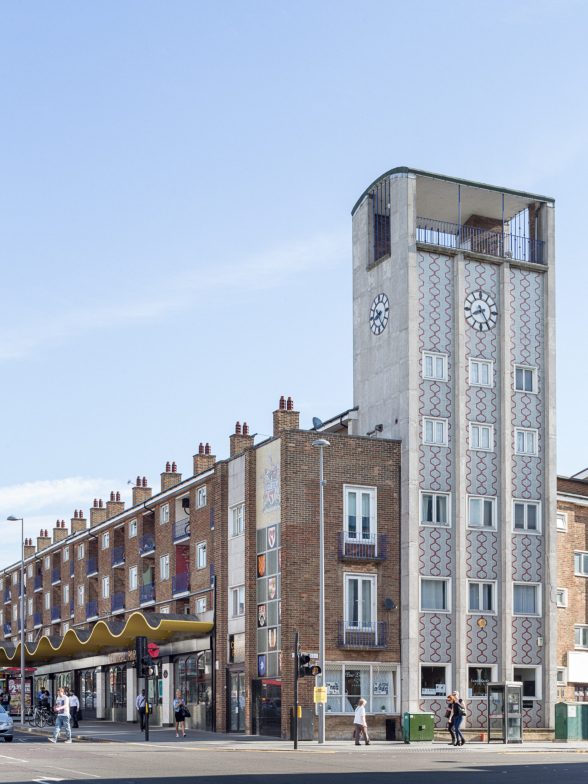This website uses cookies
This website uses cookies to enable it to function properly and to analyse how the website is used. Please click 'Close' to accept and continue using the website.



Image credit: Jon Farman (Flickr)
C20 Society has made a made a listing application for Shipley Clock Tower in Bradford, West Yorkshire, in a bid to make the 1960s structure the first post-war listed clock tower in the north of England. Designed in 1960-61 as part of a redevelopment of Shipley town centre by the Arndale Property Trust, the freestanding 6 storey tower is in a late ‘Festival of Britain’ style and stands above the surviving Market Hall, overlooking the Market Square. While the architecture of the surrounding Arndale development has been largely altered, the clock tower survives remarkably well.
Plans to upgrade the now shabby and cluttered Market Square were recently unveiled by Bradford Council, including more green areas and an all-weather canopy to cover stalls. Meanwhile the council have also produced a draft town centre development framework for public consultation, which includes a long term aspiration to “regenerate the clock tower and use this as a visitor attraction and viewing platform…”.
Of the four post-war clock towers currently on the national register, all are in the south of England or the Midlands, in part due to their popularity as civic gestures in the first wave of New Towns, few of which were developed beyond the green belt around London. With Shipley being a rare exception, the Society feels listing the tower would help address this regional imbalance, while recognising the buildings historic interest as part of an important early redevelopment by the Arndale Property Trust.

Image credit: Jonathan Taylor
‘Innocent joy’
When the post-wart town centre redevelopment was complete, chairman of Shipley Council, Coun. Stanley Rodway, favourably compared it to the nearby model industrial village of Saltaire (now a UNESCO World Heritage Site), built “Just up the road about 100 years ago”.
The central market complex accommodates shops at street level with offices at first floor level, which wrap around the off-centre, freestanding clock tower. Below the shops is an underground market hall, accessed by steps and escalator within the clock tower. The tower itself is built of concrete and faced in panels of yellow brick laid in Flemish bond, with alternating panels of textured brick separated by reconstituted stone bands in a hexagonal pattern. Offset trapezoidal balconies jut out at third and fourth storey levels, while the the upper level is open to the elements and once contained a spiral stair. The top level is clad in white ceramic tiles, with clock dials to its four faces (sadly removed in recent years), and on its principal face a nude male jacquemart figure that strikes a bell. The clock’s return elevations have vertical concrete vents, while inside the clock tower, the original U-shaped stair survives, with its timber handrail and base rail and terrazzo treads. The tower survives in excellent condition, aside from some minor losses – the clock fascia’s have been removed in the past decade – which could feasibly be restored.
The Shipley clock tower and market hall features in Owen Hatherley’s Modern Buildings in Britain: A Gazetteer, in which he describes how “In this small mill town in the City of Bradford…[a clocktower with] the sort of gaiety and pleasure in detail cuteness that is so commonly found in Coventry, but rarer in the hard townscapes of West Yorks. There are various routes into the market, but the most enjoyable is to enter through the base of the clock tower itself, where a cubic glass passageway, treated like a Mondrian grid, has inset into it a stairwell to the market below. Sometimes modern architecture was about innocent joy, and that’s what differentiates it from the ponderous Victoriana that dominated towns like Shipley.”

Image credit: Jonathan Taylor
Arndale Property Trust
The redevelopment was led by the Arndale Property Trust. Historian Alistair Kefford has written about Arndale – in The Life and Death of the Shopping City: Public Planning and Private Redevelopment in Britain since 1945 (2022) and ‘The Arndale Property Company and the Transformation of Urban Britain, 1950-2000’ (2022) – and has argued that the developers had a major role in the transformation of urban space and society in post-war Britain. The company was formed in 1950 by Arnold Hagenbach and Sam Chippindale and established an office in Wakefield, before moving to Bradford in 1964 to occupy Arndale House. Local authorities would provide land and Arndale would supply the design and management in return for a very favourable rent. Arndale built 20 shopping centres in England between 1960 and 1980, mostly in the midlands and north. Shipley was Arndale’s second development following Jarrow in County Durham. Arndale published the Shipley development in their brochures ‘Shipley Town Centre’ (1962) and ‘Arndale in Partnership with Local Authorities’ (1965).
Four post-war clock towers are currently listed on the national register, all at Grade II:

Image credit: Historic England

Image credit:

Image credit: Historic England

Image credit: Gort Scott

Become a C20 member today and help save our modern design heritage.